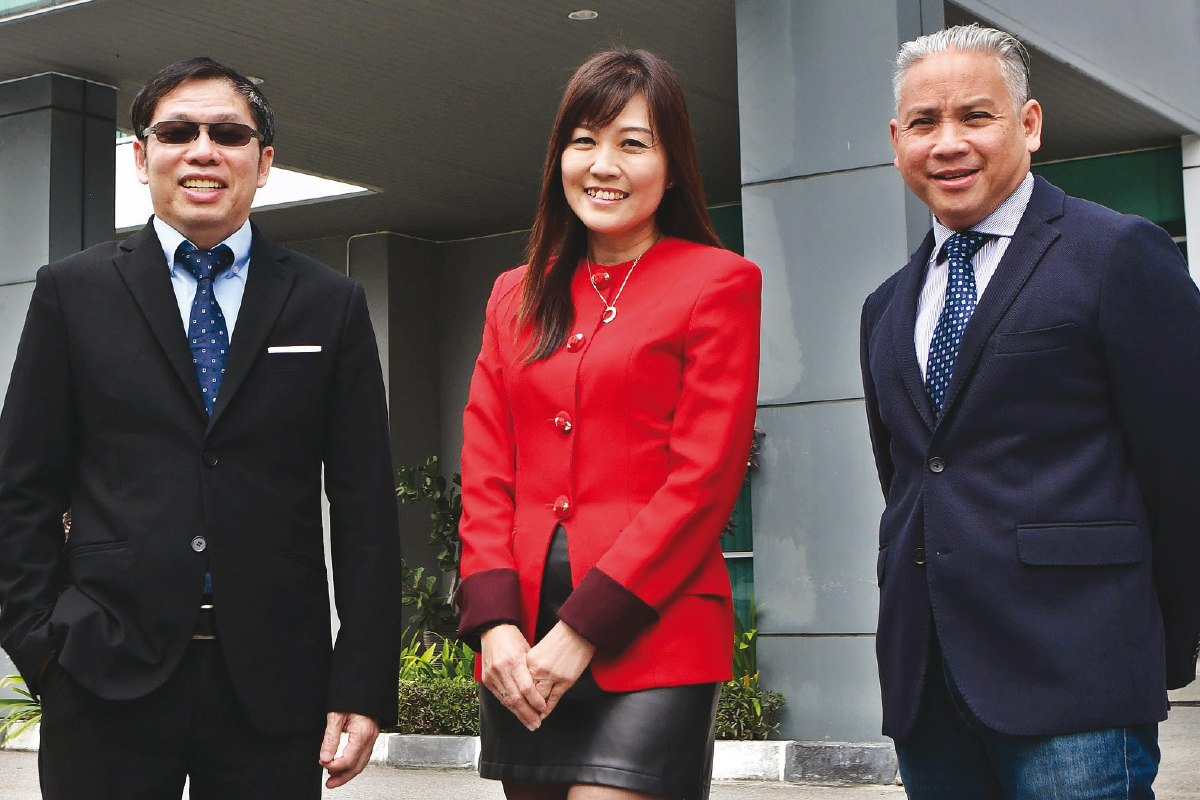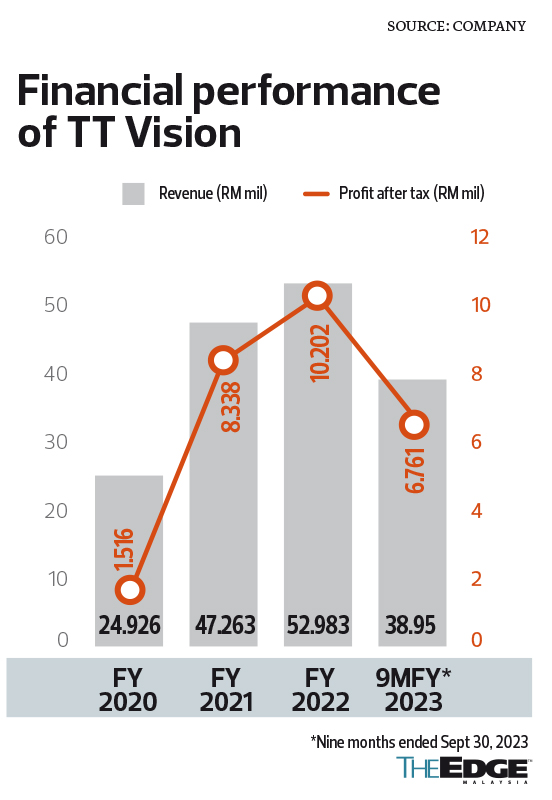
TT Vision is undertaking a two-phase expansion plan to almost double its floor space by 52,000 sq ft
This article first appeared in The Edge Malaysia Weekly on February 12, 2024 - February 18, 2024
IN anticipation of an increase in orders from customers in the optoelectronics, semiconductor and solar cell industries, Penang-based automated test equipment (ATE) manufacturer TT Vision Holdings Bhd is currently in the process of doubling its production capacity and floor space.
TT Vision co-founder, CEO and executive director Goon Koon Yin highlights that the ACE Market-listed technology firm is undertaking a two-phase expansion plan to almost double its floor space by 52,000 sq ft. From an existing floor space of 53,000 sq ft, TT Vision will have a total floor space of 105,000 sq ft by early next year.
“The year 2023 was a busy one for us as we moved from the LEAP Market to the ACE Market,” he tells The Edge in an interview at its headquarters in Bayan Lepas. “Despite some delays in orders, we continued to make progress as we started our capacity expansion project.
“We are now seeing orders and demand gradually come back from all customer segments, and we believe this is a positive sign for our financial performance moving forward. In fact, we have won multiple contracts to deliver solar cell inspection and sorting equipment for some of the world’s biggest solar players.”
The Phase 1 expansion is slated for completion by July this year, followed by Phase 2 in early 2025, says the 54-year-old. “Hopefully, we can secure more orders by the time our new capacity comes on stream. Currently, 80% of our existing floor space has been utilised. We are comfortable with such a level as it’s always better to have some buffer capacity in our business.”
As at 3QFY2023, TT Vision’s order book stood at RM72 million.
TT Vision, which listed on the LEAP Market of Bursa Malaysia in 2019, undertook a voluntary withdrawal of its listing status in 2021, and was delisted in May 2022. Subsequently, the company was listed on the ACE Market in January 2023, raising total gross proceeds of RM28.73 million.
For perspective, TT Vision has four business divisions: optoelectronics inspection equipment, discrete component and integrated circuit (IC) inspection equipment, solar cell inspection equipment, and vision-guided robotic equipment. The group has a diversified customer base consisting of 20 to 30 active global clients, which include light-emitting diode manufacturers, solar cell makers, IC players, outsourced semiconductor assembly and test companies, electronics manufacturing service (EMS) providers, parts and components producers, as well as automotive-related systems manufacturers.
“TT Vision is very much in the core supply chains of the semiconductor and solar industries. From optoelectronics and IC to solar cell, these three industries will be riding the mega trends such as electric vehicles and renewable energy … They are poised to grow faster in the coming years due to higher adoption of technology and artificial intelligence. We are delighted that TT Vision has exposure to these industries,” says Goon.
According to German online platform Statista, revenue in the optoelectronics market is projected to show a compound annual growth rate (CAGR) of 2.08% from 2023 to 2027, resulting in a market volume of US$53.41 billion (RM254.71 billion) by 2027.
Meanwhile, Statista’s data also show that revenue in the semiconductor market is expected to have a CAGR of 7.42% from 2023 to 2027, resulting in a market volume of US$736.4 billion by 2027.
As for the global market for solar panels, it is expected to see a CAGR of 8.86% from 2023 to 2033, resulting in a market share of US$355.24 billion by 2033, according to US-based market research organisation Future Market Insights.
TT Vision was founded by Goon and his husband-and-wife business partners Joe Wong Yih Hsow and Jennie Tan Yen-Li in May 2001. Wong is the group’s chief operating officer and executive director, while Tan is its executive chairman. Goon and Wong have a direct stake of 21.51% each.
It is worth noting that Khazanah Nasional Bhd’s wholly-owned strategic investment firm Malaysian Technology Development Corporation Sdn Bhd (MTDC) is a substantial shareholder of TT Vision with a 14.157% stake. TT Vision initially secured a venture capital investment from MTDC, of RM8.75 million through the issuance of 8.75 million redeemable cumulative convertible preference shares.
The group’s top 30 largest shareholders include savvy investor Tan Sri Chua Ma Yu’s CMY Incubator Sdn Bhd, Eastspring Investments Bhd, Areca Capital Sdn Bhd, Phillip Pearl Fund and Gibraltar BSN Strategic Fund.
TT Vision’s top and bottom line grew steadily from the financial year ended Dec 31, 2020 (FY2020) to FY2022. The group’s revenue rose from RM24.926 million in FY2020 to RM47.263 million in FY2021 and RM52.983 million in FY2022, while profit grew from RM1.516 million in FY2020 to RM8.338 million in FY2021 and RM10.2 million in FY2022 (see bar chart).
However, the group’s financial performance was largely stagnant year on year in the nine months ended Sept 30, 2023 (9MFY2023), after registering a turnover of RM38.95 million and cumulative earnings of RM6.76 million. As at end-September last year, its net cash position stood at RM47.7 million.
TT Vision’s share price had declined 38% over the past 12 months to settle at 76 sen last Thursday, giving the group a market capitalisation of RM355.7 million. The shares are currently trading at a historical price-earnings ratio (PER) of 33 times.
For comparison, its larger-cap ATE peers ViTrox Corp Bhd, Pentamaster Corp Bhd and MI Technovation Bhd have PERs of 46 times, 33 times and 29 times respectively, whereas its small- and mid-cap peers VisDynamics Holdings Bhd, QES Group Bhd and Elsoft Research Bhd have PERs of 29 times, 18 times and nine times respectively.
Outsourcing model
Goon points out that unlike many of its ATE peers, TT Vision does not get heavily involved in in-house workshop activities such as computer numerical control machining, wiring, and assembly and parts fabrication operations.
“Our business model is that we outsource these jobs to our partners, so that we can focus on research and development (R&D). Our suppliers and outsourcing partners will deliver the parts to us, and our job is to integrate the full equipment, test it out and commission it here,” he says.
In short, TT Vision’s idea is to better maximise the group’s floor space for higher-value activities such as R&D and final assembly, says Goon.
“We have been practising this business model and it has worked well so far, which explains why our net margin has been maintained at a decent level of about 20%. I think the key here is to make sure we continue to secure more high-value jobs, so that we can continue to improve our profit margin,” he says, adding that by maintaining a good relationship with suppliers and outsourcing partners, TT Vision could also use their floor space if needed.
“Even if the orders come in before our capacity expansion is completed, we will still be able to deliver because we can leverage our outsourcing capacity or virtual capacity by utilising our suppliers’ floor space.”
Save by subscribing to us for your print and/or digital copy.
P/S: The Edge is also available on Apple's App Store and Android's Google Play.
- China suppliers mock tariffs with Nike, Lululemon deals on TikTok
- Tariff shock awaits China after trade surplus hits US$103 bil
- Malaysia declares state funeral for Tun Abdullah Ahmad Badawi
- Reach Energy, Cahya Mata, Able Global, Pestec, Bina Puri, Jentayu Sustainables
- US steps up probes into pharmaceutical, chip imports, setting stage for tariffs



